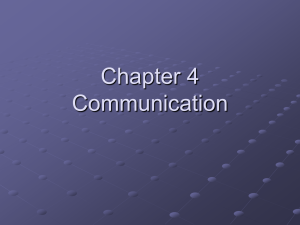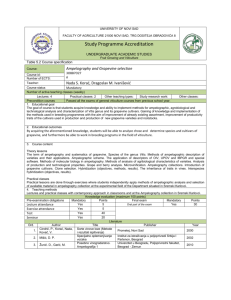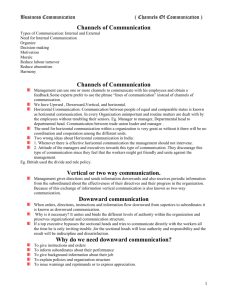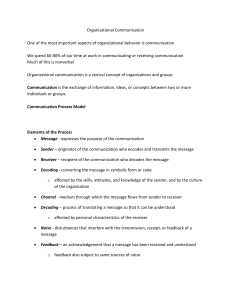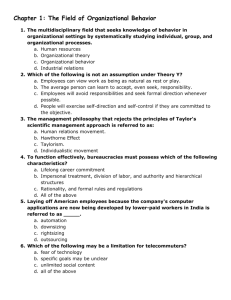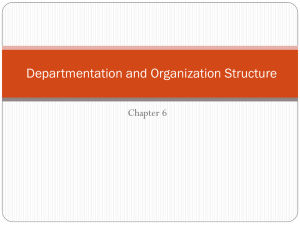The Formation of Groups
advertisement
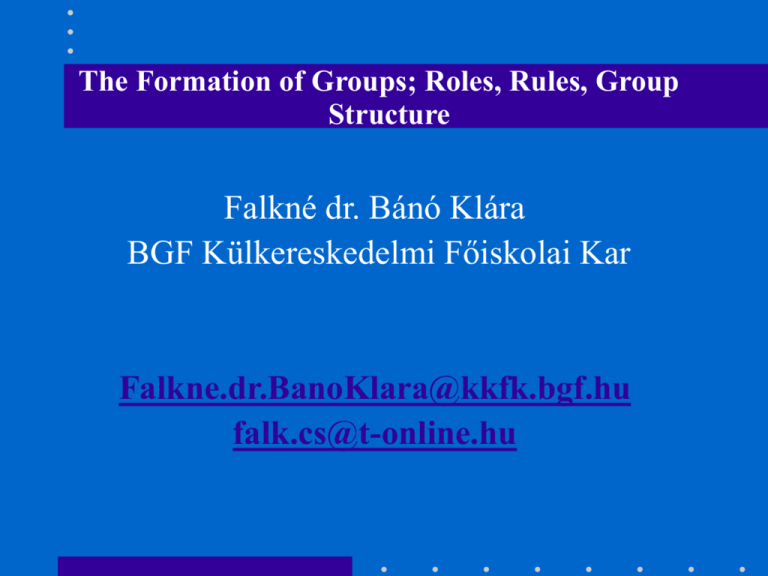
The Formation of Groups; Roles, Rules, Group Structure Falkné dr. Bánó Klára BGF Külkereskedelmi Főiskolai Kar Falkne.dr.BanoKlara@kkfk.bgf.hu falk.cs@t-online.hu Definition of a psychological group A psychological group is any number of people who: • interact with each other, • are psychologically aware of each other, • perceive themselves to be a group. Characteristics of a psychological group: • • • • • A minimum membership of two people, A shared communication network, A shared sense of collective identity, Shared goals, Group structure. Reasons for Formation of Groups • Certain tasks can only be performed through the combined efforts of a number of individuals working together; • Groups may encourage collusion between members …providing individuals with opportunities for initiative and creativity. (e.g. sharing or rotating unpopular tasks); • Groups provide companionship and a source of mutual understanding and support from colleagues; Reasons for Formation of Groups • Membership of the group provides the individual with a sense of belonging; • The group provides guidelines on generally acceptable behaviour; • The group may provide protection for its membership. - groups are a potential source of motivation/job satisfaction and a major determinant of effective organisational performance. Strong and cohesive workgroups can have beneficial effects on the organisation. (Mullins) Types of Groups Formal: • Formed from the formal organisational structure through the division of labour, • Consciously created by somebody for a reason, • Have formal structure, • Are task orientated, • Tend to be permanent, • Their activities contribute directly to the organisation’s collective purpose. (Can be: permanent committees and temporary formal groups, e.g. task groups) Types of Groups Informal: • Unplanned by the organisation, • Emerge through and are based on personal interactions, relationships, • Serve to satisfy members’ psychological and social needs, • They compensate for membership of formal groups which neglect higher level needs, • Members may meet on a social basis after work. Classification scheme for types of groups GROUPS – Reasons for Joining • SECURITY AND PROTECTION • AFFILIATION • ESTEEM AND IDENTITY • TASK ACCOMPLISHMENT The Hawthorne Studies At Hawthorne Plant of Western Electric Company, in a suburb of Chicago (1924-1932) Elton Mayo Four main research phases: 1. The illumination experiments 2. The Relay Assembly Test Room Study 3. The Interviewing Programme 4. The Bank Wiring Observation room Study THE CONCLUSIONS DRAWN FROM THE HAWTHORNE STUDIES • Workers respond primarily to the social context of the workplace. • The workers’ need for recognition and a sense of belonging are important. • A person’s attitude to work is shaped by the group to which he/she belongs in the company. • Informal groups or cliques are powerful. (4th stage) The worker is more responsive to the social forces of his/her peer group than to the controls and incentives of management. The Hawthorne Studies The Hawthorne studies highlighted the importance of the informal groups for the individual to be able to satisfy personal needs. Nowadays - more important than ever! called now – NETWORKING, i.e.meeting new people, using informal links, using people and being used by them. Group formation (adapted from Homans’ theory) Group Formation (adapted from Homans’ theory) GROUPS: Stages of Development (Tuckman 1965) • FORMING – testing and dependancy concerns, the polite stage • STORMING – division of power concerns, the ‘why we are here’ stage, hostility, conflicts emerge, cliques form • NORMING – rule making concern, ‘bid for power’ stage norms, rules of acceptable behaviour emerge • PERFORMING – achieving goals concern, constructive stage • ADJOURNING (Tuckman and Jensen 1977) – disbanding, reflecting GROUP STRUCTURE ‘…is the relatively stable pattern of relationships among the differentiated elements in a group.’ (Buchanan) The differentiation occurs along several dimensions: e.g. • STATUS – Status structure • POWER – Power structure • LIKING – Liking structure • ROLE – Role structure • LEADERSHIP – Leadership structure • COMMUNICATION – Communication structure GROUP PROCESS is the sequence of interaction patterns between the members of the group. GROUP STRUCTURE and GROUP PROCESS are interrelated. The STRUCTURE of a group can affect its PROCESS and vice versa. THE STRUCTURE-FORMING elements may differ in two respects: • whether they consider the EXTERNAL or the INTERNAL world of the group • whether they are more TASK - oriented or PERSONALITY - oriented. CLASSIFICATION of Structures Internal factors: role structure - task oriented liking structure – personality oriented External factors: power structure – task oriented status structure – personality oriented CLASSIFICATION OF STRUCTURES STATUS STRUCTURE Status is a prestige ranking within a group. • FORMAL STATUS – refers to a collection of rights and obligations associated with a position, as distinct from the person who occupies that position. Within an organisation a value is ascribed to a position by the formal organisation. E.g. Vice President, etc. – this can be labelled formal status STATUS STRUCTURE • SOCIAL STATUS – is the relative ranking that a person holds and the value of that person as measured by a group, i.e. the social honour or prestige that is accorded an individual in a group by the other group members. It is a measure of informally established value. POWER STRUCTURE Power is the control over persons. Social power is the potential influence that one person exerts over another. French and Raven identified different types of power base: e.g. Reward power – e.g. mother and child Coercive power – e.g. traditional father and child concept Legitimate power – e.g. person accepting a judge’s ruling Referent power – e.g. a pop fan adopting the hair or dress style of his idol Expert power – e.g. professor-student relationship LIKING STRUCTURE refers to the way in which members differentiate themselves in terms of whom they like and do not like. To identify the liking structure of a group we can use a technique called - SOCIOMETRY. SOCIOMETRY is a method of indicating the feelings of acceptance or rejection or indifference among members of a group. (originally developed by J. Moreno in 1934) SOCIOMETRY and SOCIOGRAM SOCIOMETRY displays patterns of human relationships in the group and can be represented diagrammatically in the form of a SOCIOGRAM SOCIOGRAM is a visual illustration of the pattern of interpersonal ralationships derived from SOCIOMETRY. Sociogram of a ten-person group GRAPEVINE STRUCTURE In an informal group a special kind of communication system, called GRAPEVINE emerges. The most typical forms of GRAPEVINE Structures: The most important features of grapevine communicational networks: • The grapevine carries information that the formal system does not wish to carry. • The grapevine is faster than the formal communicational network. • The grapevine is rather accurate. • The grapevine has its unusual ability to penetrate even the tightest company security screen because of its capacity to cut across organisational lines. ROLE STRUCTURE SOCIAL ROLE – is the set of behaviours that are expected of the occupant of a position by other members of the group. PERCEIVED ROLE – behaviours which the person himself believes are appropriate for him to enact. ENACTED ROLE – behaviours which the person actually engages in. Functions/Roles of Group Members Members of a group have both task roles/functions and group maintenance roles/functions. TASK functions help the group accomplish its task and include: • Initiating: suggesting a new idea, a new way of looking at a problem, or a new activity. • Seeking useful information or opinions: requesting facts; asking about feelings; asking for ideas. • Giving useful information or opinions: offering facts; stating a belief; making suggestions. Functions/Roles of Group Members TASK functions (cont.): • Clarifying: probing for meaning; defining terms; restating, enlarging, or stating issues. • Summarising: reviewing; bringing related ideas together; restating suggestions of others. • Consensus testing: checking to see if group is ready to decide. Functions/Roles of Group Members GROUP MAINTENANCE roles help the group to build feelings and attitude and include: • Harmonising: compromising; reconciling disagreements; getting others to explore differences. • Gate keeping: inviting others to talk; suggesting time limits or other procedures to permit wide participation; keeping talk flowing. • Encouraging: being friendly, warm, responsive through words or facial expression; agreeing with others. Functions/Roles of Group Members GROUP MAINTENANCE roles (cont.): • Following: going along with the group; being a good listener; showing that words are heard. • Standard setting: testing the group’s attitudes toward its procedures; suggesting procedures; stating values or ethics; supporting standards. How group formation is related to job content and process and to task and maintenance roles/functions
